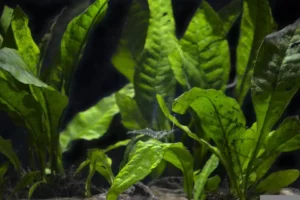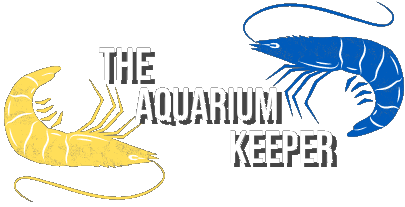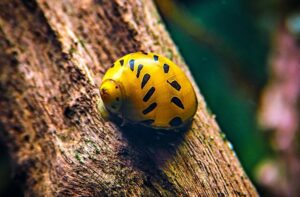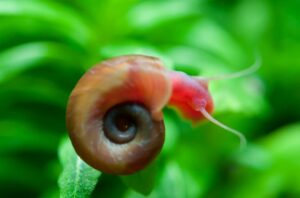
Amano Shrimp vs Ghost Shrimp: Which is Better?

Writer at The Aquarium Keeper
Amano and ghost shrimp are both interesting, peaceful aquatic creatures, that can be an excellent addition to a community aquarium. There are a lot of instances, where new aquarium keepers confuse the two species together. This can happen because of the looks of the shrimp, but both species are very unlike creatures. Continue reading, because we are going to talk about all the dissimilarities in this amano shrimp vs ghost shrimp comparison article.
Differences Between Amano Shrimp and Ghost Shrimp
To begin, amano shrimp and ghost shrimp can sometimes look similar, but both species have distinctive appearance features, that can be used to tell the two apart. Amano shrimp and ghost shrimp also tolerate different water parameters and have different breeding processes.
It is important not to confuse these two species, because that can result in bad care for your shrimp. Imagine if you buy a ghost shrimp, but created the right environment for amano shrimp. Your ghost shrimp would not thrive in that environment, so that is why it is crucial to know the distinctive differences between amano and ghost shrimp.
You might also like to read: 5 Best and Worst Tank Mates for Your Cherry Shrimp
Appearance
Most beginner fishkeepers can’t tell amano shrimp from ghost shrimp apart. The two distinctive features of these species are size and body coloration.
How do Amano Shrimp Look?
Firstly, amano shrimp is one of the largest freshwater aquarium fish in the hobby. These species can reach up to 2 inches (5 cm) in length. In most cases, females are larger than males, and reach 2 inches (5 cm), while males can only grow to about 1.5 inches (4 cm).


Another distinctive feature, that separates amano shrimp from ghost shrimp is body coloration. Usually, amano shrimp have brownish, greyish, blueish, or even reddish body colors. The color of amano shrimp largely depends on the environment and the food they are consuming. Also, males have distinctive dots, that are travelling through out their bodies, while females have stripes.
How do Ghost Shrimp Look?
Ghost shrimp are not called “ghosts” for a reason. These species have transparent bodies, that help them hide from predators in the wild. Ghost shrimp are very unique because you can literally see their internal organs because of their transparent body. Some shrimp might have brownish or greyish dots on their body, but unlike amano shrimp, these dots are barely visible.

Another difference between ghost shrimp and amano shrimp is their size. Ghost shrimp can only reach up to 1.5 inches (4 cm). Both males and females reach the same size, and there is barely any difference between both sexes, so it is hard to tell whether a ghost shrimp is female or male.
Water Parameters
Good water conditions are important because shrimp can sometimes be very fragile to bad water parameters. Amano shrimp and ghost shrimp have different water needs because both species originate from different parts of the world.
Best Water Conditions for Amano Shrimp
Amano shrimp originate from Japan and Taiwan and can live in brackish water and freshwater environments. In nature, juvenile amano shrimp spend most of their time in brackish waters, and after maturing, they migrate to freshwater parts.
Nevertheless, most people keep amano shrimp in freshwater aquariums, so it is important to know the best water parameters for a freshwater habitat. Here are the most optimal freshwater conditions for amano shrimp:
- Water temperature: 18–27 °C (64–80 °F)
- pH: 6.0–7.5
- Water Hardness: 200 ppm
All of these water parameters can be easily measured. Temperature can be checked by an aquarium thermometer, which is available in almost every aquatic store, while pH and water hardness can be checked by purchasing an aquarium water test kit. It is important to keep amano shrimp in these water parameters because they can have trouble molting.
Best Water Conditions for Ghost Shrimp
Ghost shrimp, or “glass shrimp” originates from North America, and can purely live only in freshwater, unlike amano shrimp. Shrimp are delicate creatures, that do not like sudden changes in water parameters, so be sure to ensure the best conditions for your pets. Here are the most optimal water parameters for ghost shrimp:
- Water temperature: 22–28 °C (72–82 °F)
- pH: 7.0–8.0
- Water Hardness: 150–200 ppm
Unlike their amano counterparts, ghost shrimp enjoy slightly warmer water, which is more alkaline. Both shrimp species do not like having ammonia or other bad toxins in their tank, so be sure that your aquarium water is free of ammonia before putting shrimp in it.
Stocking
You can keep a different number of amano shrimp compared to ghost shrimp in the same aquarium. Amano shrimp grow way bigger, which is why you can keep less of them in the same quantity of water, compared to ghost shrimp.
How Many Amano Shrimp can Live per Gallon?
A good rule of thumb is that you need about 2.5 gallons (9.5 liters) per amano shrimp. It means you could keep up to 2 amano shrimp in a 5-gallon tank, and up to 3-4 amano shrimp in a 10-gallon tank. This is the maximum limit of shrimp you could keep, and we would recommend going with a lower number of shrimp because it would require less maintenance, and your amano shrimp would have more space.
How Many Ghost Shrimp can Live per Gallon?
Ghost shrimp are way smaller than amano shrimp, which means you can keep a lot more of them in the same water quantity. You can easily keep the maximum number of 4 ghost shrimp per 1 gallon of water (3.8 liters). It would mean, that you could keep about 20 ghost shrimp in a 5-gallon tank, and 40 shrimp in a 10-gallon tank. Similar to amano shrimp, we would recommend keeping a slightly lower number of ghost shrimp than maximum, because it would require less maintenance, and your tank would be less crowded.
Lifespan
Lifespan is another factor, that you might want to consider before choosing between amano shrimp or ghost shrimp. Some species are hardier and can live for a bunch of years, while others don’t even reach a year. It is a similar situation when comparing amano and ghost shrimp.
How Long do Amano Shrimp Live?
Due to their size and ability to handle different water parameters, amano shrimp can live up to 2-3 years. It even takes about 6 months for these species to fully mature. Some fishkeepers even have amano shrimp that live longer than 3 years, simply because the aquarium conditions are very good for them. If the water parameters are not optimal for amano shrimp, they might not even reach maturity and can die young.
How Long do Ghost Shrimp Live?
Ghost shrimp are very sensitive to drastic water parameter changes, and can die instantly. In most cases, ghost shrimp can live up to 6 months, compared to amano shrimp, which live a very short life.
Breeding
Breeding can be one of the more interesting aspects when it comes to shrimp. Usually, almost all freshwater aquarium shrimp species breed a lot and often, it can be interesting to see how your shrimp colony is developing and growing.
How to Breed Amano Shrimp?
Unlike other aquarium shrimp, amano shrimp is one of the hardest to breed. It was believed, that it is impossible to breed amano shrimp in captivity because the breeding is very complex and everything has to be according to plan. Amano shrimp usually mate in freshwater, then the female moves to brackish water to have her babies. Baby amano shrimp grow for some time in brackish water, before moving to freshwater.
Simulating these conditions can be difficult because having some water parameters different than needed can lead to amano shrimp babies dying, or in general adults not breeding. Nevertheless, here is a short step-by-step guide on how to breed amano shrimp:
- Set up a separate breeding freshwater aquarium, that should be at least 20 gallons. Install an air pump, a filter, and lightning in the breeding tank.
- Move your shrimp to a breeding tank (preferably an equal number of males and females), and make sure the water temperature and pH are not too different from their new home because it would stress them out.
- Create the right water conditions for breeding. The water temperature should be raised to about 21–27 °C (70–80 °F), while pH should be between 6.0–7.5. Don’t change these parameters too drastically, because big changes in water conditions can hurt your amano shrimp. Over the span of days, change these parameters.
- Provide lots of quality protein-rich food for your amano shrimp. You can use special pellets created for shrimp.
- If your shrimp are sexually mature and have plenty of food, they will eventually breed. Before breeding, the female will usually molt, after that, she is ready to mate. Females release a hormone into the water, that signals the males to breed. After the mating process, a female will have a bunch of eggs just below her stomach.
- The next step is to wait for the eggs to develop. When amano shrimp eggs start to lighten up in color, it means they are about to hatch. It can take up to 24 hours for the hatching process to end. When it stops, you will have a bunch of baby amano shrimp larvae in your breeding tank.
- For amano shrimp to grow and develop, they need brackish water. They can survive up to 1 week in freshwater, so be prepared to set up a 1-gallon tank for your baby amano shrimp. It can be a simple lunch box or a betta cup. The best salinity for this brackish water tank should be 25-35 PPT.
- Be sure to also have an air pump and a light installed in the new 1-gallon brackish water tank. The light will be a good source for growing algae.
- When there are some visible algae, move your baby amano shrimp larvae to the new breeding tank using a pipette.
- You do not need to feed your larvae, because the best food for them at that stage is algae.
- Perform small water changes every month, and be sure to top off the evaporated water, so that the salinity levels don’t rise too much.
- When your shrimp starts to metamorphize, it would be a signal to start moving them to a freshwater tank. Your shrimp will start swimming rapidly, and it is physically visible, that they changed in appearance.
- Unlike when you first moved them in brackish water, your baby amano shrimp will need to be acclimated to freshwater. Use a small hose and drip acclimate your new shrimp. Make sure there is at least 1 water drop every second. Do this for about 24 hours, and then you can move your shrimp into a freshwater tank.
As you see, breeding amano shrimp is very hard, and in most cases, people just decide to buy them instead of trying to create a colony. Breeding amano shrimp is really not for beginners, so if you are just starting out, do a lot of research before trying to breed amano shrimp.
How to Breed Ghost Shrimp?
Ghost shrimp breeding is very similar to neocaridina shrimp breeding. These species do not need brackish water to mate, and can perfectly do it in basic water conditions. Here is a short guide on how to breed ghost shrimp:
- For them to breed, make sure that they have plenty of quality food, and that the water temperature is about 27 °C (80 °F), because that is the best temperature for them to breed. Also, make sure that your ghost shrimp are not stressed. To reduce stress, check for water quality (there has to be no ammonia), and at the same time provide your shrimp with a lot of plants and hiding places.
- As we mentioned before, it is very hard to sex ghost shrimp, so be sure to have a bunch of them if you want to have ghost shrimp babies.
- Similar to amano and neocaridina shrimp, female ghost shrimp releases a chemical into the water, that signals the males for breeding purposes.
- When you create the perfect breeding conditions for your ghost shrimp after a few weeks look for shrimp with eggs. If you found any, you can place them in a breeder tank with the same water parameters, light, and air pump.
- Ghost shrimp eggs should hatch within 2-3 weeks, and after they do, you can place the female back into the main tank.
- Feed your ghost shrimp babies regularly, and when they get bigger, introduce them back into the main tank.
Breeding these species is way simpler, and can be easily done as a beginner. Just be sure to have a plan on where to put your new ghost shrimp, because they reproduce quickly.
Price and Availability
Price is another factor that should be considered before buying any pet. When it comes to these basic shrimp species, the price is relatively not that high, and both amano shrimp and ghost shrimp can be easily found in a bunch of aquarium stores.
How Much Does Amano Shrimp Cost?
Amano shrimp are more expensive than ghost shrimp, simply because it is way harder to breed them, and you can’t house that many. That is why they are selling for a higher price, although they are very affordable. The average price for an amano shrimp should be between 3$ and 15$. It vastly depends on your location and the availability of amano shrimp.
How Much Does Ghost Shrimp Cost?
Ghost shrimp are very easy to breed, so they do not cost much. Also, people tend to buy a bunch of them in one purchase, so having a high price for a single ghost shrimp would be a bad idea. Usually, ghost shrimp sell for 1$ to 3$. It depends on where are you located, and what is the demand and supply for these species in your area.
Similarities Between Amano Shrimp and Ghost Shrimp
Moving on, we have successfully covered all the differences between amano and ghost shrimp. It is time to break down all the similarities these two species have.
Tank Setup
Both species need at least 5 gallons of water to feel okay. Neither amano shrimp nor ghost shrimp would do well if there is no air pump, filter, heater, and light in your aquarium. These components are essential in every aquarium, and although some people have success keeping shrimp with barely any tech, we do not recommend doing it for beginners.
Filter
You need a filter because it helps clean your aquarium water. A filter creates a flow, which circulates your aquarium water through parts of your filter, where there are a lot of beneficial bacteria. This results in bacteria dealing with bad toxic things like ammonia, resulting in making your aquarium water clean. We highly suggest purchasing a filter, that can circulate twice as much water per hour as your aquarium water volume. So if you have a 5-gallon tank, at least get a filter, that can circulate 10 gallons of water per hour.
Air Pump
An air pump is also essential to any tank setup because it helps oxygenate your aquarium water. Every aquatic creature needs oxygen to breathe, and an air pump displaces aquarium water with bubbles, letting oxygen get into the water, and carbon dioxide exit.
Heater
You need a heater if you are living in conditions, where the temperature usually changes a lot. A heater really helps maintain the same temperature in aquariums and can be a lifesaver in colder climates. It does not cost a lot, so be sure to get one if you reside in a colder part of the world.
Light
Lightning is also important because it helps algae to grow in your aquarium, which shrimp love to eat. You somehow need to see your fish to actually enjoy the hobby, that is why you need an aquarium light. Most basic aquarium lights are usually enough unless you have very needy aquarium plants.
Decorations
Amano and ghost shrimp are still relatively small creatures compared to fish, and can sometimes feel shy and threatened. It is crucial that there are enough hiding places provided for them. We highly suggest having a lot of different plants for shrimp, so that they could hide and feel safe in them. Also, decorations like rocks, driftwood, and castles are good, because it creates extra gaps and caves, that only shrimp can fit in. Amano and ghost shrimp also like places, that are dark, because they feel safer in them.
Diet
Both amano and ghost shrimp are carnivores, which means they enjoy protein-rich food, and at the same time like to get their nutrients from dead plants and algae. Both species are scavengers and opportunists, which means they also like to eat uneaten fish food, dead fish, and dead shrimp. As you can see, amano and ghost shrimp have a big appetite and can eat a vast majority of things. Here are the following food types you can feed your amano and ghost shrimp:
- Algae wafers
- Sinking algae or protein-rich pellets
- Frozen/live bloodworms
- Blanched vegetables (zucchini, spinach, carrots)
- Fish flakes
You should feed your shrimp different food often because it is important to give them all the nutrients to breed and molt. Also, if you see that your shrimp stopped eating algae in your aquarium, it means that you are overfeeding them. Try feeding amano and ghost shrimp 1 time per day.
Tank Mates
Both amano and ghost shrimp can live with small peaceful nano-fish and snails. Keeping them with bigger predatorial fish like betta fish, angelfish or gourami would be a bad idea, because they would get easily eaten.
Small fish, that has a peaceful character and mind their own business is the best tank mates for amano and ghost shrimp. Here is a short list of good tank mates with similar tank conditions:
- Neon tetra
- Rummy nose tetra
- Celestial pearl danio
- Guppy fish
- Cardinal tetra
- Chili rasbora
- Mystery snail
- Nerite snail
- Ramshorn snail
- Pygmy corydora
- Otocinclus
- Kuhli loach

All of the fish mentioned above are very peaceful, and would not have the physical capabilities of eating alive adult amano or ghost shrimp. They might try to eat baby shrimp, but would rarely succeed, and to prevent this, you can keep baby shrimp in a separate tank until they grow bigger.
Frequently Asked Questions
Can Amano and Ghost Shrimp Live Together?
Both shrimp species can easily coexist in the same aquarium because they tolerate similar water parameters and are not aggressive. Just be sure to feed them enough, because amano shrimp are way bigger than ghost shrimp, and they can bully ghost shrimp when it is feeding time.
Do Amano Shrimp Eat Cherry Shrimp?
Amano shrimp will not harm your cherry shrimp unless they are very hungry and haven’t been fed for days. Amano shrimp can try to eat your baby cherry shrimp, and that is an act of desperation because there is no other food source around the tank. Be sure to feed your shrimp regularly, so you would not have this problem.
Writer's Thoughts
I believe, that both shrimp species are very unique pets to have in a community aquarium. They are amazing at cleaning, although I would favor amano shrimp over ghost shrimp, simply because they look better for me, and are bigger.
If you enjoyed reading our article, please feel free to share it with your friends by clicking the social media buttons below:





